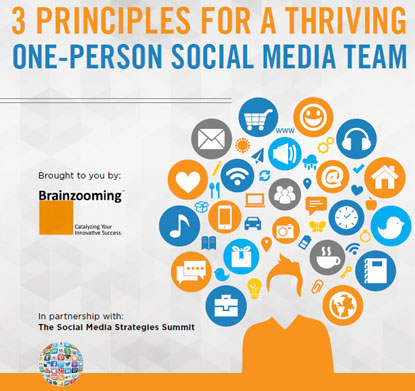I’ve just signed on to speak at the 2016 Social Media Strategy Summit in Las Vegas. The topic will be an update to the “Staying Sane as a Solo Social Media Professional” workshops I’ve delivered at previous Social Media Strategy Summit events (and elsewhere). The challenge is, however, it’s just a 45-minute presentation. That’s going to necessitate some judicious trimming to highlight the very top tips for a solo social media professional to focus and enhance a brand’s content marketing strategy!
2 Ways to Decide When to Write What with Your Content Marketing Strategy
One of the new solo social media tips under consideration involves this tip I used to help shape the Brainzooming content marketing strategy for this year.
The only thing about this content marketing strategy tip, however, is it requires two things:
- At least one year (and ideally two or more years) of blog content published at a fairly regular frequency
- Several blogs on your core topic areas that are generating ongoing search traffic throughout the year
Granted, those two content marketing strategy hurdles, depending on where you are blogging from, can seem either easy or incredibly challenging.
If you have met both of these hurdles, however, take a look at the month-by-month visits for your posts with the most robust ongoing traffic.
The big step is to compare the percent of yearly traffic you receive each month for a specific post to a typical standard for visits. There are two options for the standard you use:
- That standard could be 1/12 of your annual traffic (i.e., you’d expect to get an average share of visits each month).
- Alternatively, your standard could be the percent of total annual traffic your overall blog receives each month throughout the year.
No matter which standard you choose, for each month divide the percent of visits the post received by your standard for that month, then multiply all the results by 100.
What this will show is that for any month whose resulting number is over 100, there is greater than average interest in the topic that month. When the number is less than 100, it indicates disproportionately less interest in the topic.
This content marketing strategy approach helped prioritize nine of our most frequently-covered topics for the year. It highlighted that "innovation" is a popular topic throughout the year, and confirmed that "strategic planning" is most popular during the late summer and early fall months.
Never having used this approach to shaping a content calendar, I can’t report what it does to grow visits. The approach will, however, definitely help in keeping a focus throughout the year on what topics should be more popular at any given time. – Mike Brown





